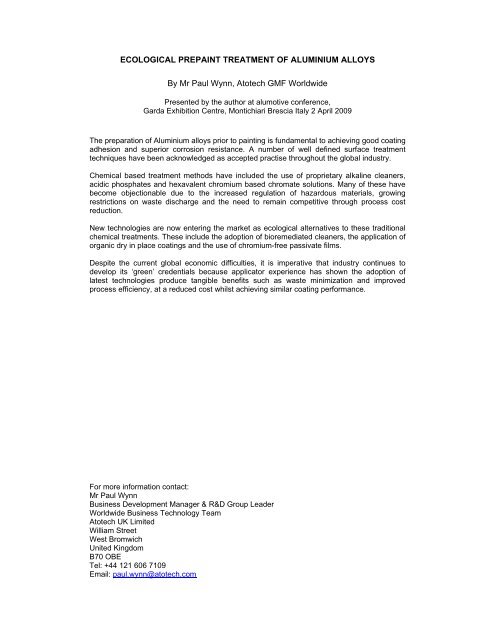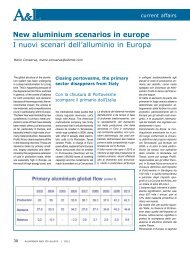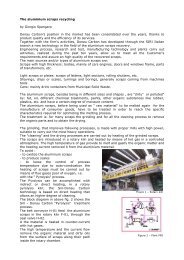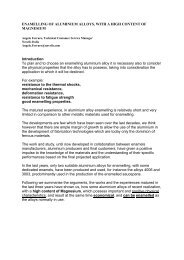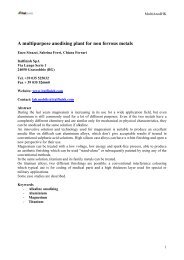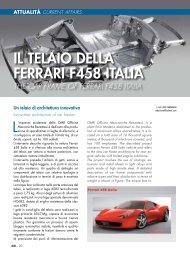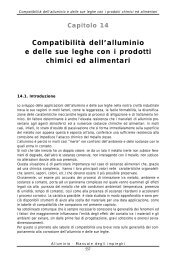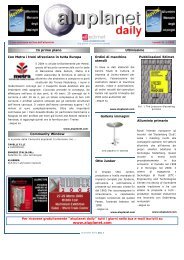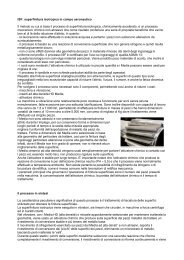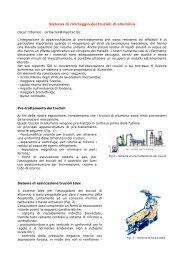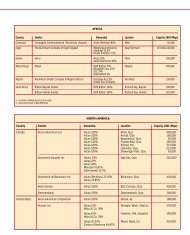ECOLOGICAL PREPAINT TREATMENT OF ALUMINIUM ... - Aluplanet
ECOLOGICAL PREPAINT TREATMENT OF ALUMINIUM ... - Aluplanet
ECOLOGICAL PREPAINT TREATMENT OF ALUMINIUM ... - Aluplanet
You also want an ePaper? Increase the reach of your titles
YUMPU automatically turns print PDFs into web optimized ePapers that Google loves.
<strong>ECOLOGICAL</strong> <strong>PREPAINT</strong> <strong>TREATMENT</strong> <strong>OF</strong> <strong>ALUMINIUM</strong> ALLOYS<br />
By Mr Paul Wynn, Atotech GMF Worldwide<br />
Presented by the author at alumotive conference,<br />
Garda Exhibition Centre, Montichiari Brescia Italy 2 April 2009<br />
The preparation of Aluminium alloys prior to painting is fundamental to achieving good coating<br />
adhesion and superior corrosion resistance. A number of well defined surface treatment<br />
techniques have been acknowledged as accepted practise throughout the global industry.<br />
Chemical based treatment methods have included the use of proprietary alkaline cleaners,<br />
acidic phosphates and hexavalent chromium based chromate solutions. Many of these have<br />
become objectionable due to the increased regulation of hazardous materials, growing<br />
restrictions on waste discharge and the need to remain competitive through process cost<br />
reduction.<br />
New technologies are now entering the market as ecological alternatives to these traditional<br />
chemical treatments. These include the adoption of bioremediated cleaners, the application of<br />
organic dry in place coatings and the use of chromium-free passivate films.<br />
Despite the current global economic difficulties, it is imperative that industry continues to<br />
develop its ‘green’ credentials because applicator experience has shown the adoption of<br />
latest technologies produce tangible benefits such as waste minimization and improved<br />
process efficiency, at a reduced cost whilst achieving similar coating performance.<br />
For more information contact:<br />
Mr Paul Wynn<br />
Business Development Manager & R&D Group Leader<br />
Worldwide Business Technology Team<br />
Atotech UK Limited<br />
William Street<br />
West Bromwich<br />
United Kingdom<br />
B70 OBE<br />
Tel: +44 121 606 7109<br />
Email: paul.wynn@atotech.com
Introduction<br />
All metallic surfaces require preparation prior to the application of performance enhancing<br />
surface coatings. The key to successful aluminium processing is to understand the type of<br />
alloy to be processed, the final performance requirements and then to use a suitable<br />
pretreatment process.<br />
Aluminium is extremely versatile due to the wide variety of alloys available, with differing<br />
mechanical and protection properties, supported by a number of suitable surface coatings.<br />
Three of the main properties on which applications of aluminium are based are its low density,<br />
high mechanical strength when alloyed and the relatively high corrosion resistance of the pure<br />
metal. The pure metal displays the highest corrosion resistance, but as alloying elements are<br />
added, this resistance decreases. In particular the development of high strength alloys<br />
containing heavy metals such as copper and zinc, has increased the need for protective<br />
surface treatments. Copper lowers resistance more than other elements, whilst magnesium<br />
has the least effect.<br />
There are two abundant forms of commercial alloy, as outlined on slide 1. Wrought alloys,<br />
which are cast as ingots or billets, then hot and cold worked mechanically into extrusions,<br />
forgings, sheet, foil, wire or tube. Common types include 2000 series for aircraft plus 5000<br />
and 6000 in automotive. Cast alloys are directly cast into the required form by sand, gravity or<br />
pressure die casting techniques. Although there are a large number of castings alloys, most<br />
of these derive their properties from the addition of magnesium, silicon and copper. Examples<br />
include AA380 used for automotive wheels and ADC12 to make carburettors.<br />
Aluminium Types<br />
Wrought Alloys<br />
Alloy<br />
Series<br />
Ty pi cal Applic ations<br />
Al 99.00%<br />
min<br />
1000<br />
food, chemical, sheet<br />
Copper<br />
2000<br />
aircraft<br />
Magnesium<br />
Magnesium &<br />
Silicon<br />
5000<br />
6000<br />
cans, automobile, facades, transportation<br />
automobile, architectural, transportation<br />
Cast Alloys<br />
Seri es<br />
All oy<br />
Ty pi cal Applic ations<br />
AA356<br />
AA380<br />
ADC12<br />
Si 7.5%<br />
Si 8.5%, Cu 3. 5%<br />
Si 10%, Cu 3%<br />
Zn 2%<br />
pressure castings for vehicles<br />
(carburetors, wheels, suspension,<br />
transmission housings), aircraft, electrical<br />
appliances, cookware<br />
Slide 1: examples of Aluminium types<br />
The alloy that should be used in any particular application will depend upon factors such as<br />
the mechanical and physical properties required, the material cost and the service<br />
environment involved. If a surface treatment is to be applied, then the suitability of an alloy for<br />
producing the particular finish will be an additional consideration.<br />
Aluminium Finishing<br />
Pure aluminium displays excellent corrosion resistance, largely due to its affinity for oxygen.<br />
This results in the production of a very thin but tenacious oxide film which covers the surface.<br />
Aluminium can provide satisfactory performance without finishing treatments in many<br />
applications, but potential problems from corrosion are usually reduced or eliminated by the<br />
use of a coating.<br />
The choice of finish and substrate alloy will depend upon a number of considerations, such as<br />
the nature of the service environment, the final finish appearance required, processing cost<br />
and others such as formability and electrical resistance. In addition to retaining its original
appearance coatings and deposits can give colour, add other decorative effects and improve<br />
overall corrosion protection. There are a diverse range of finishes applied to aluminium and its<br />
alloys. Principal amongst the commercially important types are:<br />
• Anodic oxidation coatings, which are commonly known as anodizing. These are<br />
electrochemically produced oxide coatings which provide maximum protection.<br />
• Chemical conversion coatings. These can be characterised as thin oxide, phosphates or<br />
chromates that are used for light service conditions and as a base prior to the application<br />
of paint and other organic coatings.<br />
• Electroplated deposits with suitable surface preparation. A full range of decorative and<br />
functional electroplates can be applied onto aluminium.<br />
• Painted finishes. These are organic based technologies such as paint, powder coatings<br />
and lacquers enabling greater flexibility in texture, colour and functional properties.<br />
Coated aluminium is an important material, being widely used by a number of global<br />
industries such as consumer products, transport and construction.<br />
Treatment Process<br />
The tenacity of aluminium’s natural oxide film has a serious adverse effect in the production of<br />
surface treatments, so it must be removed or modified before coatings can be successfully<br />
applied. The main function of conversion coatings such as phosphate or chromate is to<br />
improve adhesion and corrosion protection of paints under wet and dry conditions, whilst<br />
improving the corrosion protection of the uncoated metal surface. They are formed as a result<br />
of reaction of the metal surface with a wide range of different chemical solutions. They can<br />
both be successfully applied in bulk volumes by spray or immersion. It is common to utilise<br />
three stage, five stage or longer process lines. The actual number of treatment stages is<br />
guided by the type of substrate being processed and the final performance requirement.<br />
A typical conveyorized five stage spray washer prior to painting or powder coating, is shown<br />
in slide 2. In this example, the initial surface preparation is by spray alkaline cleaning.<br />
Following water rinsing, an iron or zinc phosphate will be applied or it can be a chromate<br />
conversion. After further water rinsing, an acidic seal may be applied, particularly for<br />
phosphate applications where increased corrosion protection is required. The treated<br />
components would then be oven dried prior to painting.<br />
Treatment Process<br />
Treatments improve adhesion and corrosion resistance<br />
Alkaline Clean > Phosphate or Chromate > Oven Dry<br />
Spray Zo nes<br />
Alkaline<br />
clean<br />
Water<br />
Rinse<br />
Phosphate<br />
or<br />
Chromate<br />
Water<br />
Rinse<br />
Acidic<br />
seal<br />
Oven<br />
Dry<br />
Slide 2: five stage spray line
Alkaline Clean<br />
Aqueous alkaline cleaning is the most important stage in surface preparation. Working at<br />
elevated temperature and solution pH, the traditional powdered chemical cleaners are<br />
designed to provide rapid and uniform surface wetting of the aluminium surface. They will<br />
break up and disperse surface soils from the substrate.<br />
Since aluminium is readily attacked by high pH, specialist formulations are used that operate<br />
at comparatively low alkalinity and pH, whilst being inhibited to ensure they are non-etching.<br />
Under normal operation, the working solution will become increasingly contaminated over<br />
time and process efficiency is reduced, as indicated on slide 3. Whilst additions of the<br />
formulation chemistry can be made to achieve short term performance improvements, a<br />
saturation point will be reached and the process solution has to be disposed of and replaced.<br />
The regular replacement of cleaning solutions increases overall process costs and in addition<br />
to the cleaner concentrate, there will be further costs and liabilities associated with waste<br />
disposal.<br />
Alkaline Clean<br />
Performance against Time<br />
Slide 3: solution performance against time<br />
Phosphating<br />
Phosphates originally developed for steel have been adapted for aluminium. Formulations<br />
contain a metal acid phosphate solution, an oxidizing agent and a complex fluoride which<br />
accelerates the deposition process. Coatings are formed as a result of the reaction of<br />
aluminium in phosphoric acid with fluoride as the principal reaction driver. The main<br />
requirement of the metal in solution (iron or zinc) is to form an insoluble phosphate during<br />
reaction. Saturation of the solution at the interface leads to the deposition of the phosphate<br />
coating.<br />
Amorphous iron phosphate and crystalline zinc phosphate treatments have been frequently<br />
used prior to painting. The primary component of zinc phosphate deposits on aluminium is<br />
hopeite Zn 2 Fe(PO 4 ) 2 .4H 2 O. Iron phosphate coatings typically consist of vivanite<br />
Fe 3 (PO 4 ) 2 .8H 2 O and magnetite Fe 3 O 4 .<br />
Phosphate processes are highly acidic and operate at elevated temperature. The mechanism<br />
involved is complex, but during the precipitation reaction, insoluble phosphate compounds are<br />
formed as by-products. These take the form of sludge and scale, which deposit and build onto<br />
application equipment reducing process efficiency, examples of these can be seen in slide 4.<br />
These typically cause the clogging of spray nozzles, the blocking of pipes and pumps, plus<br />
the scaling of the washer. Sludge formation consumes approximately 20 to 40% of process<br />
chemistry, therefore regular additions are critical to maintain efficiency and performance.
One of their main advantages is their effectiveness as a pretreatment for other metals,<br />
making is possible to process mixed metals such as iron, steel, zinc and aluminium on the<br />
same line. Therefore they have gained considerable importance in vehicle manufacturing.<br />
Phosphating<br />
Insoluble phosphate by-products<br />
• Precipitate as sludge and scale<br />
Slide 4: examples of sludge and scale residues<br />
Chromating<br />
Chromating is based upon the oxidation of aluminium by an acidic solution containing<br />
hexavalent chromium and fluoride ions. The process modifies the surface characteristics of<br />
the natural oxide layer to form a more corrosion resistant coating of chromium oxides.<br />
Chromium containing products of the reaction are deposited on the metal surface to form the<br />
conversion coating.<br />
Hexavalent chromium is responsible for the well known ‘yellow’ colour. The chromate coating<br />
is a gelatinous olation polymer of mixed chromium oxides and has a characteristic ‘mudcracked’<br />
surface, the result of dehydration of the film under drying. It is used on all alloy types<br />
in a multitude of applications, providing excellent adhesion and superior corrosion resistance.<br />
Generally chromates have outperformed zinc and iron phosphates on Aluminium, due to the<br />
superior corrosion resistant properties of hexavalent chromium in addition to the increased<br />
depth of pitting that occurs on phosphate treated surfaces. However Hexavalent Chromium<br />
compounds have become increasingly regulated and are already being replaced in a number<br />
of key areas including electronic, electrical and automotive components.<br />
Ecological Treatments<br />
Commercial industrial treatments based upon alkaline cleaners, acidic phosphates and<br />
chromates are under increasing scrutiny due to the regulation of hazardous materials, the<br />
growing cost and restriction on waste disposal and the need to remain competitive through<br />
the use of more cost efficient processes. Therefore it has become desirable to find more<br />
beneficial and less objectionable treatments.<br />
New ecological technologies are gaining acceptance as credible alternatives and have<br />
already entered commercial service with applicators. These include the use of BioChemical<br />
cleaners, Organic dry-in-place coatings and Chromium-free passivates. Bulk applied by spray<br />
or immersion, they are readily introduced into existing process lines and are therefore drop in<br />
replacement technologies that do not require capital investment.<br />
A clear target for industry is the provision of sustainable products that fully comply with the<br />
latest European Union Directives and Regulations. Industry also needs to meet the ever<br />
increasing demands of consumers for eco-friendly products. The desire for environmentally
friendly chemical technologies is one of the significant factors driving these new treatment<br />
methods.<br />
BioChemical Cleaning<br />
A new advance in aqueous alkaline cleaning has been achieved through the combination of<br />
latest generation inorganic and organic chemical compounds in synergy with biotechnology.<br />
Applicators would like to reduce their energy consumption, so it would be desirable to have<br />
lower temperature operating cleaners. This has been realised by the use and optimisation of<br />
increased surfactant combinations with highly active dispersants. These new formulations<br />
displace and emulsify surface soils at lower operating temperatures. At the same time there is<br />
a need for longer life of process solutions. Through the process of bioremediation, complex<br />
organic molecules such as oils, are converted into less complex, non-hazardous substances<br />
such as carbon and water. This means that a wide range of oils and soils will be consumed<br />
and eliminated from the working solution.<br />
The latest generation BioChemical cleaners utilise microbes found in nature which have been<br />
selected for their benefits to humans. They play a fundamental role in the transformation of<br />
matter in various fields and are increasingly found in industrial applications. Extensively used<br />
in the production of foods and beverages, their use has grown considerably in the chemical<br />
and pharmaceutical industries as well as modern waste water treatment plants.<br />
Under aerobic conditions, biodegradation of organic compounds will naturally occur and an<br />
effective degradation of matter can be achieved, as illustrated in slide 5. The interaction of an<br />
active biomass over time with larger organic molecules results in the formation of many<br />
smaller molecules and increased biomass. This process known as Bioremediation enables<br />
the continual repetition of this reaction on prolonged contact, creating smaller organic<br />
molecules some of which will be broken down many times an be transformed into more<br />
nicrobes, small amounts of carbon dioxide and water. This ability to continue reacting over<br />
time is one of the unique benefits from biotechnology. This approach is now successfully used<br />
in a number of industrial applications such as paint pretreatment, paint overspray treatment<br />
and waste treatment.<br />
BioChemical cleaning<br />
Latest generation chemistry<br />
Aerobic microbes<br />
Bioremediation<br />
TIME<br />
CO 2<br />
Water<br />
Oil at<br />
surface<br />
Oil, Water<br />
Surfactant<br />
Emulsion<br />
BIOMASS<br />
Surfactant<br />
Slide 5: illustration of the bioremediation process<br />
The combination of latest cleaning chemistry and biotechnology ensures consistent<br />
performance, optimum process efficiency and exceptionally long solution working life. This<br />
avoids the need for regular solution dumps, conserving both chemistry and water, whilst<br />
drastically reducing waste disposal needs. Further improvements can be achieved when<br />
BioChemical cleaners are combined with dedicated filtration equipment. This synergy
etween product and equipment enables the working solution to be continuously rejuvenated<br />
Performance improvement<br />
BioChemical & Equipment<br />
Synergy with equipment and chemistry<br />
BioFilter unit for optimum performance<br />
Consistent and optimum performance<br />
Extended working solution life<br />
and replenished, as referenced by slides 6 & 7.<br />
Slide 6: BioFilter<br />
Slide 7: optimum performance<br />
Organic Dry In Place<br />
Organic Dry In Place (ODIP) coatings are formed by drying a variety of aqueous chemistries<br />
directly onto a cleaned metal surface. Operating at room temperature, the coating chemistry<br />
is completely free of phosphates, chromium and solvents. Bulk spray or immersion applied, it<br />
will deposit a thin coating onto a range of metallic substrates such as steel and aluminium by<br />
chemical bonding, thereby reducing the influence of the substrate material.<br />
ODIP means there is no need for water rinsing, just an oven dry after application. This<br />
eliminates the need for a final water rinse, reducing energy and water consumption. Since the<br />
system does not rely on a precipitation or conversion reaction, there are no sludges and<br />
scales produced as by-products, which avoids extensive equipment cleaning. This new<br />
technology is rapidly being introduced as a replacement for iron phosphate. Adhesion and<br />
corrosion resistance is equivalent or better and is ideal if the primary performance criteria is<br />
paint adhesion and when there are a limited number of process tanks available, for example<br />
in a three stage spray line.<br />
This has found numerous applications throughout the paint and powder coating sector, for a<br />
number of substrates including aluminium. In domestic appliances it is used for the painting of<br />
white goods like cookers and washing machines. In automotive it is gaining acceptance for<br />
motorcycle parts made from wrought alloys and for car braking systems on cast alloys.<br />
ODIP coatings are applied in conventional paint pretreatment lines by spray or immersion,<br />
without the need for capital investment. The simplified bonding mechanism is shown on slide<br />
8. Aluminium is first cleaned, this would typically be a non-etch alkaline cleaner. Following<br />
water rinsing, the ODIP coating solution is applied by either spray or immersion. As there are<br />
no precipitation or conversion reactions taking place, it is sufficient to fully wet the surface.<br />
The chemistry contains active functional groups which chemically bond to the metal oxide<br />
sites during oven drying.<br />
Following successful pretreatment, an organic coating such as powder coat, can be directly<br />
applied to the substrate surface. The powder contains active bonding sites which chemical<br />
combine with the coating during the oven curing process. This is a simplified way to show<br />
how the technology achieves highly adherent and superior bonding between metallic<br />
substrates and paint or power type coatings.
ODIP bonding mechanism<br />
Organic Dry In Place<br />
Chemical bond to metal oxide<br />
Chemical bond with powder coat<br />
Excellent paint adhesion<br />
O-<br />
O-<br />
O-<br />
R-<br />
R-<br />
R-<br />
Cleaned<br />
Aluminium<br />
Organic<br />
D I P<br />
Coated<br />
Aluminium<br />
Powder<br />
Coating<br />
DIP-O-<br />
DIP-O-<br />
DIP-O-<br />
DIP-<br />
DIP-<br />
DIP-<br />
R-DIP-O-<br />
R-DIP-O-<br />
R-DIP-O-<br />
Painted<br />
Aluminium<br />
Slide 8: ODIP bonding mechanism<br />
Chromium-free Passivate<br />
The most versatile replacement for phosphating and chromating prior to painting, are the new<br />
Chromium-free Passivates (CFP) which are suitable for all alloy types and readily applied by<br />
spray or immersion. Completely free of chromium and phosphates, they are generally based<br />
on group four transition metals such as Zirconium or Titanium. Coatings display a mineral like<br />
grain structure which means they do not exhibit ‘mud cracking’ and are more heat resistant.<br />
Film colour is blue to iridescent, dependant upon the material being processed. Surface<br />
characteristics are shown on slide 9, contrasted against chromate.<br />
Surface characteristics<br />
CHROMATE<br />
PASSIVATE<br />
Slide 9: characteristics of chromate against passivate<br />
CFP has the benefit of being able to function on mixed metal lines processing metals such as<br />
aluminium, steel and zinc thereby giving the applicator greater flexibility. Studies have shown<br />
that passivate performance is independent of solution operating temperature when used over<br />
steel and galvanised substrates, therefore it allows the applicator to benefit from room<br />
temperature operation. For aluminium and magnesium, whilst room temperature operation
produces more than acceptable results and the highest levels of performance are achieved<br />
when the solution is operated at elevated temperature around fifty centigrade.<br />
CFP technology meets latest European Union legislation, ensuring applicators and end users<br />
are fully compliant. It is an ideal replacement for phosphates and chromates when excellent<br />
paint adhesion with superior corrosion resistance is required. It has been shown to exhibit<br />
superior mechanical properties such as paint adhesion, whilst giving excellent corrosion<br />
resistance. They are highly suitable to meet a wide variety of industrial performance<br />
standards.<br />
As a ‘stand alone’ passivate film, they also show good levels of corrosion protection for<br />
everything except high copper alloys such as wrought 2000 series. The current commercially<br />
used offerings fail to consistently meet the 168h neutral salt spray level as defined by MIL-<br />
DTL-5541F. There are new areas of research which show improved ‘stand alone’<br />
performance of CFP over aluminium and it has been speculated that the minimum<br />
requirement of the standard may be achieved for high copper alloys.<br />
CFP performance.<br />
Evaluation studies have demonstrated that the performance of the final coating is essentially<br />
not dependant upon the application method of the passivate. Results shown on slide 10 are of<br />
comparative tests confirming that same performance is achieved whether CFP application is<br />
by immersion or spray. Additional validation work has been completed to determine the<br />
influence of substrate type. Slide 11 highlights the results of corrosion testing using neutral<br />
salt spray, after 700h exposure for Al 6061 wrought alloy, Galvanized sheet and Cold rolled<br />
steel. The results confirm the suitability of the technology for multi metal application, which is<br />
important for process flexibility.<br />
CFP spray vs immersion<br />
CFP substrate variation<br />
Neutral salt spray 2184 hour exposure<br />
Polyester Powder Coat nominal 50 microns thickness<br />
Neutral salt spray - 700 hour exposure<br />
Type<br />
Spray<br />
Immersion<br />
Alloy<br />
Al 6061<br />
Al 6061<br />
Paint type<br />
Epoxy powde r coat<br />
Paint<br />
thickness<br />
Nominal 50 microns<br />
Creep back<br />
mm<br />
0<br />
0<br />
Aluminum 6061 (Spray)<br />
- ASTM D1654 (Rating 10)<br />
Aluminum 6061 (Immersion)<br />
- ASTM D1654 (Rating 10)<br />
Rating<br />
ASTM 1654<br />
10<br />
10<br />
Aluminum 6061<br />
ASTM D1654<br />
Rating 10<br />
Galvanized G90<br />
ASTM D1654<br />
Rating 9<br />
Cold Rolled Steel<br />
ASTM D1654<br />
Rating 10<br />
Slide 10: application method<br />
Slide 11: substrate type<br />
To be commercially viable as a prepaint treatment for aluminium, it is also necessary to<br />
establish that CFP provides comparative performance with different aluminium alloy types.<br />
The results on slide 12 show adhesion and corrosion tests for three common alloys, all were<br />
treated through the same prepaint sequence and then coated with a polyester powder coat.<br />
After 4000 hours neutral salt spray exposure, extruded alloys Al2024, 5052 and 6061 show<br />
no signs of corrosion and no loss of paint adhesion.
CFP alloy variation<br />
Neutral salt spray at 4000 hour exposure<br />
Type<br />
A1<br />
B1<br />
C1<br />
Alloy<br />
Al 6061<br />
Al 5052<br />
Al 2024<br />
Paint type<br />
Polyester<br />
Interpon<br />
D1036<br />
Polyest er<br />
Interpon<br />
D1 036<br />
Polyester<br />
Interpon<br />
D1036<br />
Paint<br />
thickness<br />
Nominal 70 microns<br />
Creep back<br />
mm<br />
0<br />
0<br />
0<br />
Rating<br />
ASTM 1654<br />
10<br />
10<br />
10<br />
Slide 12: alloy variation<br />
Enhanced Process<br />
To achieve optimum paint performance on aluminium alloys, quality assure in-service<br />
reliability and meet the needs of demanding corrosive environments, a more extensive<br />
prepaint treatment prior to CFP has found to be beneficial, as outlined on slide 13.<br />
The enhanced sequence starts with a non-etch BioChemical alkaline cleaner as the preferred<br />
choice for surface oil removal, followed by water rinsing. This is shown on the slide optimized<br />
with the use of a BioFilter to extend performance and solution life, which is available to<br />
applicators as an option. Etching is then required to active the surface. Experience has shown<br />
that an acidic etch produces a more uniform substrate profile which is highly compatible with<br />
passivation.<br />
After etching, surface smuts may be generated which tend to be heavier the more highly<br />
alloyed the substrate type, smuts are particularly heavy on copper based alloys. They mainly<br />
consist of oxides and intermetallics which are readily removed by a suitably formulated acid<br />
treatment. Following smut removal, double water rinsing is recommended prior to passivation.<br />
Some instances have found that final finish improvements can be realized when using<br />
deionized water in the second stage rinse, but it is always recommended to use deionized<br />
water after passivation. This process route can be used effectively for both spray and<br />
immersion, and for both wrought and cast aluminium alloys.<br />
Enhanced Process<br />
Spray Zones<br />
BioChemical<br />
Clean<br />
Water Rinse<br />
Acidic Etch<br />
Water Rinse<br />
Desmutt<br />
Water Rinse<br />
Chromium-free<br />
passivation<br />
Slide 13: enhanced prepaint process
Applicator Benefit<br />
An ecological focus through the adoption of new technology makes good business sense to<br />
remain competitive today and for long term sustainability. An increasing number of applicators<br />
are making the technology change and realising tangible benefits, which include:<br />
• Reduced energy consumption, by operating at lower or room temperature.<br />
• Water conservation through extended solution life and reduced water rinses.<br />
• Waste minimization by significantly reducing sludge waste from cleaner and coater<br />
processes.<br />
• Improved flexibility with the ability for process lines to handle a variety of substrates.<br />
• Increased competitiveness by achieving a significant reduction in process related<br />
costs.<br />
• Using greener technology to ensure regulatory compliance.<br />
Summary<br />
The surface treatment industry continues to transform itself into a modern and technology<br />
driven business. The image of low technology and shoddy practises are disappearing. In the<br />
current economic climate, industry faces an incredible crisis from a loss of consumer<br />
confidence, which has come from a massive and collective failure in leadership of the<br />
financial system. The surface treatment industry must continue to invest in new technologies<br />
and deliver innovation to ensure it retains a value added status. The adoption of ecological<br />
prepaint treatments for aluminium alloys has been demonstrated to be commercially viable<br />
and its use is gaining credibility in a wide range of industrial sectors.<br />
References<br />
1.”The Surface Treatment and Finishing of Aluminum and its alloys” by P.G. Sheasby and R.<br />
Pinner, published by Finishing Publications Ltd sixth edition 2001<br />
2. “Phosphating and metal pre-treatment” by D.B. Freeman, published by Woodhead-<br />
Faulkner Ltd 1986<br />
3. “Replacing Hexavalent Chromium in Passivations on Zinc Plated Parts” by Paul C. Wynn<br />
and Craig V. Bishop, published in Products Finishing 2001<br />
4. “Industrial Production Shop, Yes;Hobby Coater, No” by S. Spielman, published in Powder<br />
Coated Tough 2007<br />
5. MIL-DTL-5541 F Chemical Conversion Coatings on Aluninium and Aluminum alloys,<br />
2006<br />
6. ASTM D1654 Standard Test Method for Evaluation of Painted or Coated Specimens<br />
subjected to Corrosive Environments, published by ASTM 2005<br />
7. ASTM B117 – 97 Standard Practice for Operating Salt Spray (Fog) Apparatus, published<br />
by ASTM 1997


